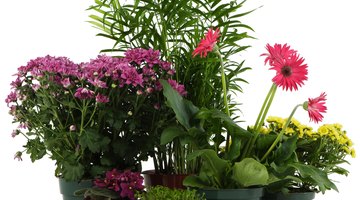Effects of Hydrogen Peroxide on Plants
Hydrogen peroxide is a clear, colorless liquid that dissolves quickly in water. Although stores and pharmacies sell it as a packaged product, it also occurs within the natural ecosystem and even in the human body. Among its many uses, hydrogen peroxide can treat wounds, clean clothes and care for plants.

The effects of hydrogen peroxide on plants can be extremely beneficial if used in the right concentrations and conditions.
Effects
According to the U.S. Environmental Protection Agency, farmers use hydrogen peroxide as an agricultural pesticide. It kills bacteria and insects that threaten crop yields and combats atmospheric pollution. Similar to farmers, you can use hydrogen peroxide as a spray to keep house plants free of insects and other plant diseases. When used as a diluted spray or applied to plant roots and soil, hydrogen peroxide can kill bacteria, fungi and parasites. Because hydrogen peroxide is highly soluble in oxygen and water, it reacts easily with other substances and is able to kill harmful organisms.
Types
Hydrogen peroxide comes in a variety of different concentrations. Supermarkets and pharmacies sell 3-percent grade hydrogen peroxide. While this grade is ideal as a disinfectant for both household plants and humans, it can also clean fruits and vegetables. Commercial farmers use a much higher concentration of hydrogen peroxide -- 35-percent grade -- to keep dairy, vegetables and fruits bacteria- and pest-free. Hydrogen peroxide at 6-percent grade can bleach and color hair, while the military and space exploration sectors use hydrogen peroxide at 90-percent grade.
Use at Home
Farmers and other food industry professionals using 35-percent grade hydrogen peroxide or higher generally create a diluted solution of 1-percent or less when used as an insecticide and bactericide. Create a similar solution by combining 1 oz. of 3-percent grade hydrogen peroxide with 1 qt. of water. Use 16 drops of hydrogen peroxide if using 35-percent grade solution. Spraying your plants with this diluted mixture helps plant fertility and encourages growth.
Warnings
Though you can safely use 3-percent grade hydrogen peroxide for wound treatment or as a diluted insecticide for plants, higher grades of hydrogen peroxide can be highly corrosive. For example, hydrogen peroxide with concentrations of 30 percent or more can cause skin burns. Also, ingesting or inhaling hydrogen peroxide vapors in its non-diluted form is hazardous and in some cases lethal. Nevertheless, the EPA states that if used at low concentrations and with protective equipment, higher grade hydrogen peroxide can be a safe pesticide for plants and food.
The Drip Cap
- Hydrogen peroxide is a clear, colorless liquid that dissolves quickly in water.
- Hydrogen peroxide comes in a variety of different concentrations.
- Supermarkets and pharmacies sell 3-percent grade hydrogen peroxide.
- Farmers and other food industry professionals using 35-percent grade hydrogen peroxide or higher generally create a diluted solution of 1-percent or less when used as an insecticide and bactericide.
- Though you can safely use 3-percent grade hydrogen peroxide for wound treatment or as a diluted insecticide for plants, higher grades of hydrogen peroxide can be highly corrosive.
References
Writer Bio
Bridgette is an aspiring yogini, newbie coder and seasoned marketing writer in the higher ed space. She's written hundreds of articles on a wide range of topics including, entrepreneurship, K-12 pedagogy and information technology. Bridgette's work has appeared on Connect: IT at NYU, Noodle Pros, QuickBooks Small Business Center, Trails.com and USA Today.
Photo Credits
- Jupiterimages/PhotoObjects.net/Getty Images
- Jupiterimages/PhotoObjects.net/Getty Images
More Articles


